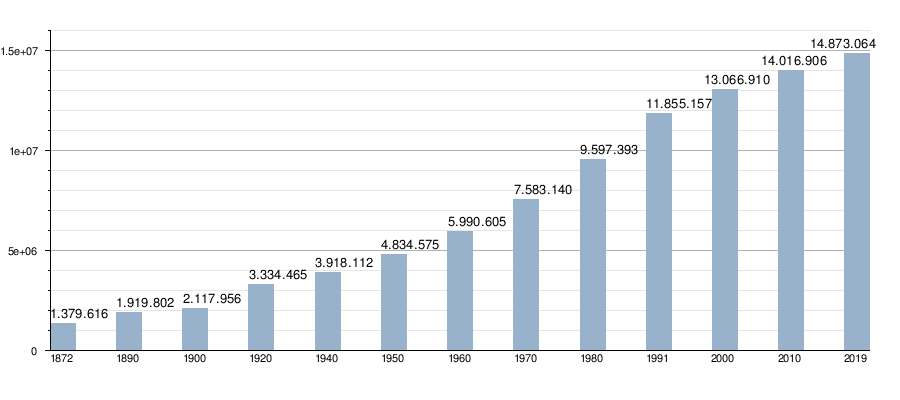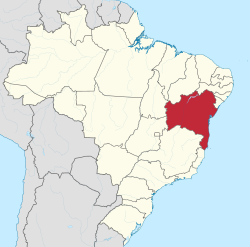Bahia
| Estado da Bahia | |||
|---|---|---|---|
| Symbols | |||
|
|||
| Basic data | |||
| Country | Brazil | ||
| Capital | Salvador da Bahia | ||
| surface | 564,733.1 km² | ||
| Residents | 14,016,906 (2010) | ||
| density | 25 inhabitants per km² | ||
| ISO 3166-2 | BR-BA | ||
| politics | |||
| governor |
Rui Costa (since January 1, 2015) |
||
| Political party | Partido dos Trabalhadores | ||
| economy | |||
| GDP | 258,649 million R $ 16,931 R $ per capita (2016) |
||
Coordinates: 13 ° S , 42 ° W
Bahia (Portuguese baía " bay "; the h is not spoken, emphasis on the i ; officially Estado da Bahia ) is a federal state in Brazil and the southernmost part of the northeast region .
geography
With an area of 567,295 km², Bahia is slightly larger than France and, according to the 2010 census by the Instituto Brasileiro de Geografia e Estatística (IBGE), has 14,016,906 inhabitants. The IBGE estimated the population at 14,873,064 in 2019.
The capital is Salvador (historically: Salvador da Bahia de todos os Santos) , which was also the capital of Brazil until 1763. With a coastline of 1,183 km, Bahia is the Brazilian state with the longest Atlantic coast.
The neighboring states are Piauí , Pernambuco , Alagoas and Sergipe to the north, Espírito Santo and Minas Gerais to the south ( clockwise ), and Goiás and Tocantins to the west.
politics
economy
South of Salvador is the "Costa do Cacau", the cocoa coast, which is reminiscent of the cultivation of cocoa in the 18th century.
The province's mineral resources include several internationally known natural stone deposits , including those of Azul Bahia , Azul Do Macaubas and the Bahia Red and Dalva gneisses .
traffic
The main highways are BR-101 , BR-116 , BR-235 and BR-242 . Bahia also has several airports, of which Salvador-Magalhães and Porto Seguro handle most of the passengers and also offer some international connections. The state is connected to the national rail network, but the national rail traffic plays only a subordinate role. Salvador is the only city with a light rail network.
tourism
Salvador celebrates the largest and most traditional street carnival in the world. Unlike in Rio, however, there is no samba arena, so all activities take place on the streets.
The remote fishing village of Mangue Seco in the far north of Bahia became famous for filming a telenovela . These and other film locations contributed to the development of tourism in Mangue Seco.
population
Bahia is the Brazilian state with the highest percentage of black population and is considered the state with the greatest African influence. That is why it is also the center of the Candomblé religion. There are around 8,000 candomblé terreiros in the state of Bahia . The celebrities of the capital gather at the festival in honor of the sea goddess, which is all the more remarkable since the Candomblé cult was banned by the police until 1970.
The indigenous people of Bahia include the Pataxó , who have been fighting over land with the state's landowners for years. They were the first indigenous people to have contact with the Portuguese conquerors.
Population development

Source IBGE (figure for 2019 is only an estimate as of July 1, 2019)
Cities
The ten most populous cities of Bahia are according to the 2010 census of the IBGE with estimates of the population as of July 1, 2018:
![]() Map with all coordinates of the cities section : OSM
Map with all coordinates of the cities section : OSM
| local community | Population census 2010 |
2018 estimate |
|
|---|---|---|---|
| 1 |
Salvador |
2,676,606 | 2,857,329 |
| 2 |
Feira de Santana |
556,642 | 609.913 |
| 3 |
Vitória da Conquista |
306.866 | 338,885 |
| 4th |
Camaçari |
242,970 | 293,723 |
| 5 |
Itabuna |
204,667 | 212,740 |
| 6th |
Juazeiro |
197.965 | 215.183 |
| 7th |
Ilhéus |
184,236 | 164,844 |
| 8th |
Lauro de Freitas |
163,449 | 195,095 |
| 9 |
Jequié |
151,895 | 155,800 |
| 10 |
Alagoinhas |
141,949 | 150.832 |
history
In 1893, Antônio Conselheiro , a Catholic priest, and his supporters founded the Canudos settlement in the desert region of Sertão, which quickly grew to around 20,000 residents. The movement managed to live a kind of communism . However, since they were shielded from the outside world and paid no taxes, a civil war broke out between Sertanejos and the military . At the end of the Canudos War , the settlement was destroyed and almost all of the residents were killed.
Some of the survivors settled in the Rio de Janeiro area and founded one of the first favelas there . Some linguists attribute the introduction of the term “favela” to the name of a slum-like settlement to this foundation, as “favela” originally referred to a plant in the Sertão.
At the village Lobato were in exploration , the first on January 21, 1939 Oil - deposits of Brazil discovered.
Partnerships
Bahia has had a partnership with the city of Chongqing , People's Republic of China , since 2011 .
Web links
- Bahia, Governo do Estado , Government Page (Brazilian Portuguese)
- Legislative Assembly website , ALBA, Assembleia Legislativa da Bahia (Brazilian Portuguese)
- Bahia em números 2014 , core data of the Superintendência de Estudos (Portuguese)
Individual evidence
- ↑ a b c Bahia - Panorama. In: cidades.ibge.gov.br. IBGE , accessed September 1, 2019 (Brazilian Portuguese).
- ↑ Guia Geográfico Salvador ( Memento from August 8, 2018 in the Internet Archive ). Retrieved December 5, 2017 (Brazilian Portuguese).
- ↑ IBGE : Cidades: Bahia . Retrieved July 19, 2015 (Brazilian Portuguese, English, Spanish).
- ↑ Bulletin of the American Association of Petroleum Geologists , Vol. 34, Part 1, p. 963 , accessed on January 21, 2012
- ^ Chongqing Municipal Government




